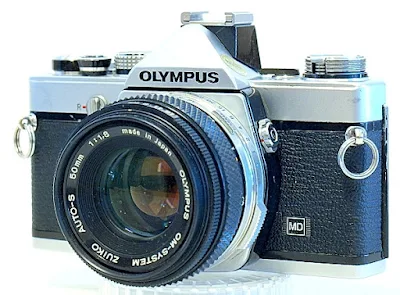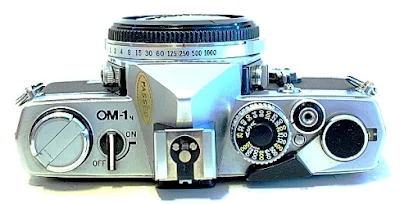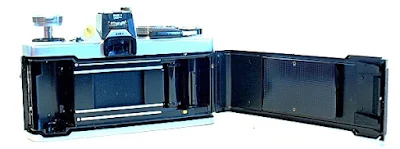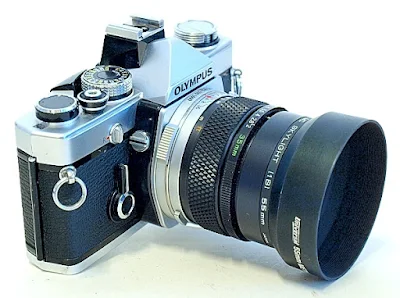The Olympus OM-1n, one of the 'iconic' greats of the 35mm SLR film camera era, is a fully manual autoexposure 35mm single-lens reflex camera, that has remained a favorite with collectors and enthusiasts over the years since it was first launched, and has strived to retain its charm as one of the most compact 35mm SLR film camera ever produced.
The series, which started with the launch of the Olympus M-1, later renamed OM-1, in 1972, evolved to the OM-1 MD in 1974, now adaptable to the OM autowinder and motor drive system. The final iteration of the model, the OM-1n, was launched in 1979 and came with a redesigned film advance lever, a flash-ready LED in the viewfinder, and automatic flash synchronization with the new Flash Shoe 4.
Conceptualized from the start as a system camera, the professional 1-digit series was optimized with advanced features and durability, supported by a wide range of OM-mount Zuiko branded lenses, renowned for their compactness and image quality, and a whole range of accessories and ancillaries that paves the way for the OM-System to be truly professional.
Olympus OM-1n Camera Review
This video is about Olympus OM-1n camera. One of the favorites in my collection. I did include some images at the back end of the video in case you are interested. Taken with various Zuiko lesnes.
Professional endorsement for the OM-1 came from the likes of Patrick Lichfield, Jane Bown, David Bailey, Josef Koudelka, Chris Bonington, and Kate Garner. The OM-1n stayed in production until 1987.
Design and Build
Operationally, the all-mechanical Olympus OM-1n is fitted with a focal-plane shutter with a speed range from 1 to 1/1000 second, and Bulb, with electronic flash synch at 1/60 second, and accepts film ISO speed range from 25 to 1600. The camera is also fitted with a 4 to 12-second delay self-timer, which can be stopped and reset after actuation, and mirror lock-up.Exposure is center-weighted open-aperture TTL reading powered by a twin CDS cell system located on either side of the eyepiece. The exposure range is EV 2 - 17 (ASA 100 with F1.4 standard lens). Flash unit connectivity is via a removable Flash Shoe 4. The OM-1n is compatible with the OM Autowinder 1 and 2, and the OM Motor Drive 1.
Unique to the implementation of the OM-series of professional 35mm SLR cameras is the shutter speed control which is ring mounted on a concentric on the base of the lens mount housing, and the DoF (Depth of Field) preview button which is located on the barrel of each lens mount, which is opposite of the norm of the function being located as part of the mechanical leverages on a camera body.
Basic Camera Features
Almost the perfect 10 in conceptualization and design, the OM-1n is available in both chrome and black.The front of the camera is simple and elegant, with only the Rewind Release Lever and the Self-Timer control on the left of the lens mount housing, where the Shutter Speed Ring is located. On the vertical of the housing is the Mirror Lockup Lever, on the left, and the Flash Synchro Socket, on the right.
On the top plate, right at the extreme left is the Rewind Crank integrated with the pull-up Camera Back Release, beside which is the On/Off switch for the exposure system. Flash Shoe 4, if available, is fitted to the top of the pentaprism, while on the right of the top plate, the film ISO dial, with push-button control, Shutter Release, Film Advance Crank, and the Film Counter Window.
Aside from the super large viewfinder window, the back of the camera is plain. The film back is a hinged-type, interchangeable with Recordata Back 1, and 250 Film Back 1.
The bottom plate of the OM-1n carries the Battery Chamber and Motor Drive Socket, both capped, the Tripod Socket, and a pair of Motor Coupling Terminals.
The film box is the Olympus Easy Load system with the standard film chamber, shutter curtain, film advance sprocket, and slotted take-up spool. Make sure that the film lead is properly inserted into one of the slot openings of the take-up spool before cranking and firing the mandatory shots to properly engage the film advance mechanism.
Viewfinder Readout
One of the most alluring traits of the OM-1s, the extra-large viewfinder and super-large 97% screen coverage, is supported with the default 1-13 Matte-field microprism/split image screen with a rangefinder spot. The screen is interchangeable with 14 other options.
The screen displays a center-the-needle Exposure Index on the lower half of the left side of the screen. The correct exposure value is indicated when the needle is centered on the index.
Over- and underexposure can be adjusted by varying the shutter speed or lens aperture, and this will be indicated by the upward or downward movement of the needle (+ for overexposure, - for underexposure).
Manual Exposure Control
Setting the correct exposure value, as you like it, can be done as 'aperture-priority' i.e, pre-setting the lens aperture value while using the shutter speed to center the needle, or as 'shutter-priority' i.e. doing it in reverse, by pre-setting the shutter speed, and varying the lens aperture opening to get to the correct exposure value.Mirror Lockup
Self-Timer
The Self-Timer's function is independent of the shutter release button as well. After forwarding the film frame, start by turning the Self-Timer lever anticlockwise till it stops. This will expose a smaller secondary lever/actuator that you need to flick lightly to the right to activate the timing sequence. The lever is an On/Off manual control with which you can start and stop the timing sequence by flicking the lever back to the left.You can still use the shutter release button even when the Self-Timer is primed.
Battery
The OM-1n requires a PX625 mercury type 1.35V cell button to power its metering system. This can be replaced with the use of a 1.4V zinc-air hearing aid battery or Wein cells. You might also need a PX625/LR44 battery adapter to fit in the replacement battery. I did mine with a piece of hard paper cut to the height of the battery chamber and wound just right to fit the smaller cell size.Camera Body Weight
The Olympus OM-1n camera's body weight is 510 grams without batteries.Using The Camera
The best part of the experience was, of course, using the camera itself. First, the OM series cameras (except for the OM-10 and the Cosina-made OM-2000) are the only SLR film cameras that come with a shutter speed ring mounted on the lens housing mount.This meant that managing the focus ring, the aperture setting ring, its location outermost on the lens barrel, and adjusting the shutter speed ring can all be done with the left hand, while the right hand is used to hold the camera and to operate the shutter. Built tough and robust, the OM-1 series is equal to the task with adaptability to the motor-drive system.
The camera is an equally smooth operator, with its super large viewfinder, silky smooth film advance, a very reassuring and confident 'clunk-and-thump' mirror reflex, and shutter actuation, and with a weight of only 680 grams when fitted with a Zuiko Auto-S 50mm f/1.8, The OM-1n is no strain at all, neither to the hand and shoulders.
Image quality is, of course, responsive to the highest acknowledged OM Zuiko lenses.
























Does the OM1 Instruction manual apply to the OM1-N or is there a separate manual please
ReplyDeleteI would say that they are basically the same, except maybe for the difference to the physical sizes of the booklets, references to the different hot shoe types as fitted to OM-1, OM-1 MD, and OM-1n, and the addition of the Olympus Autowinder capabilities for the OM-1 MD, and ON-1n. Thanks.
Delete